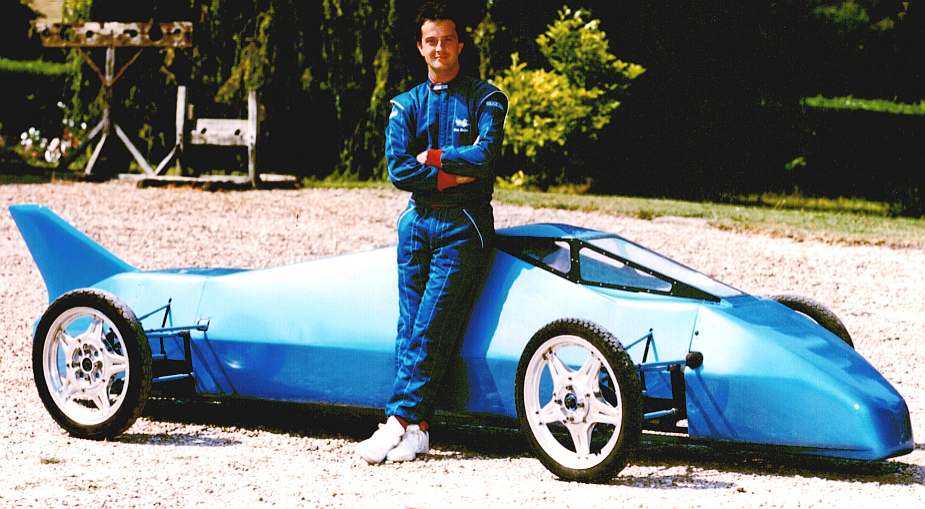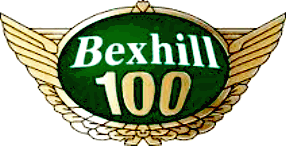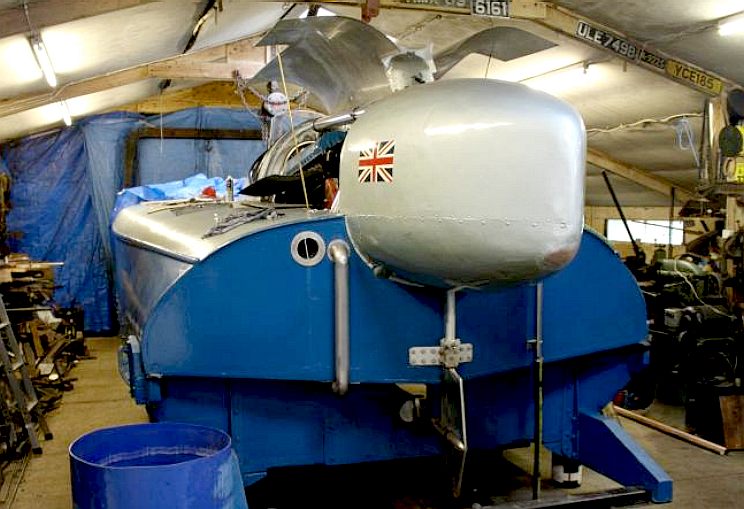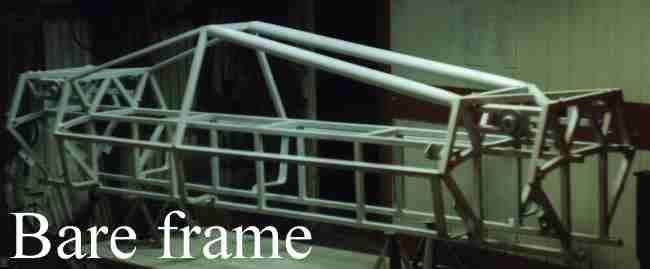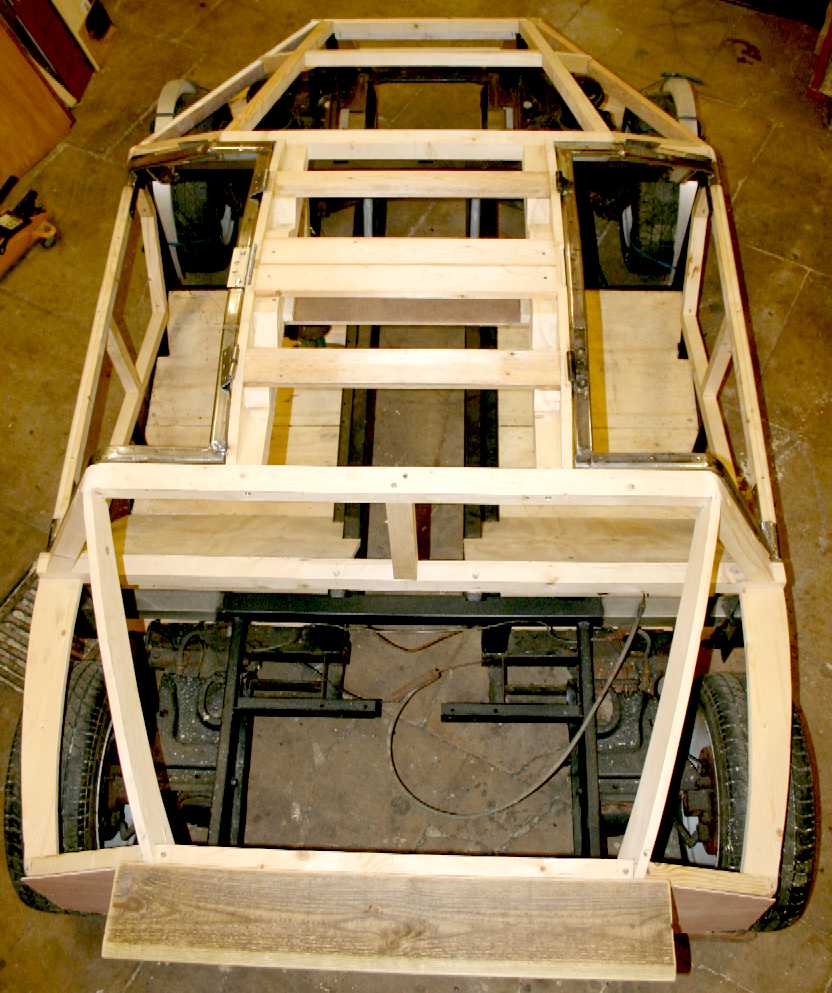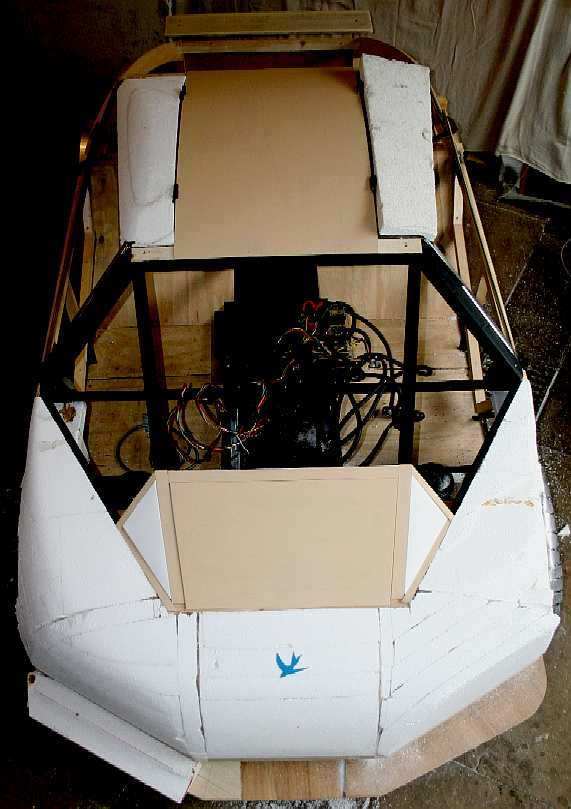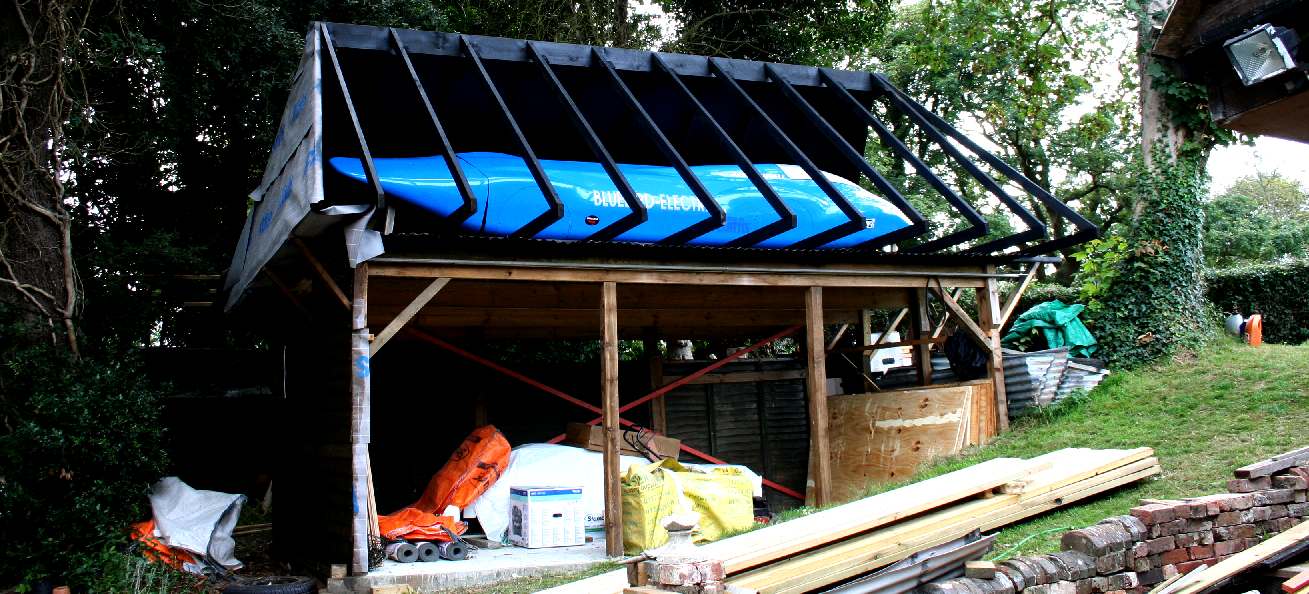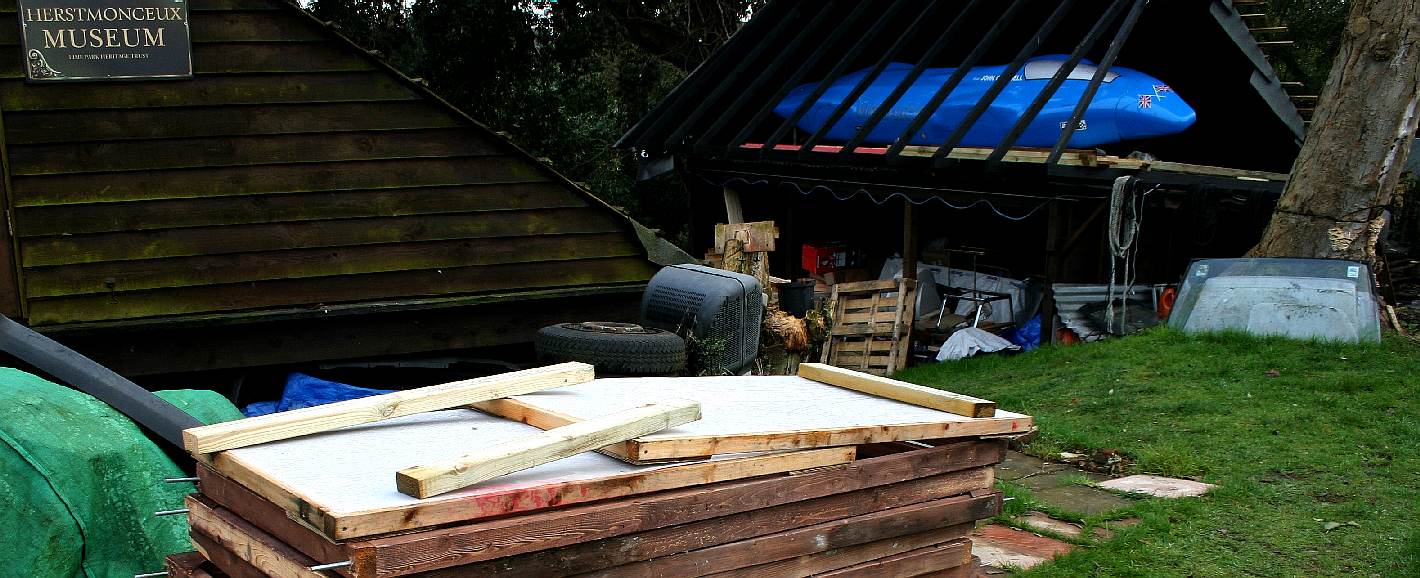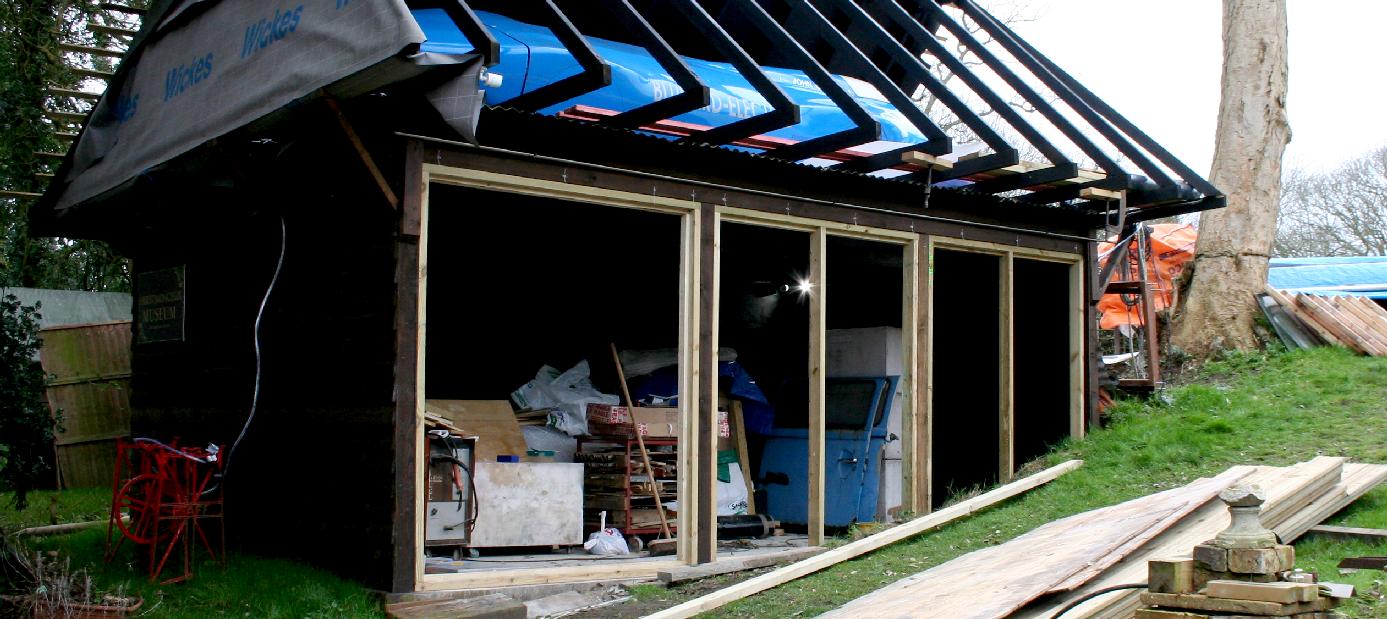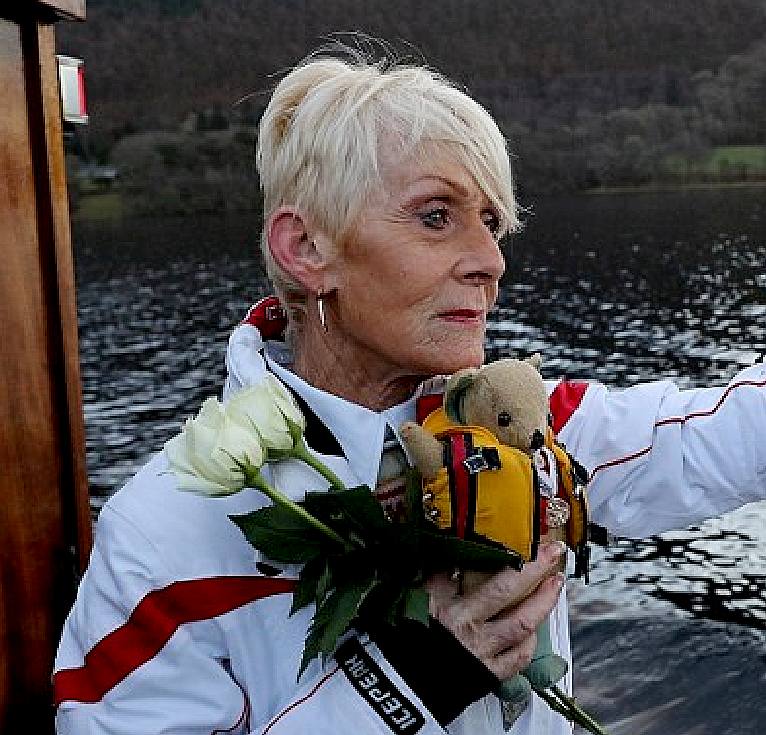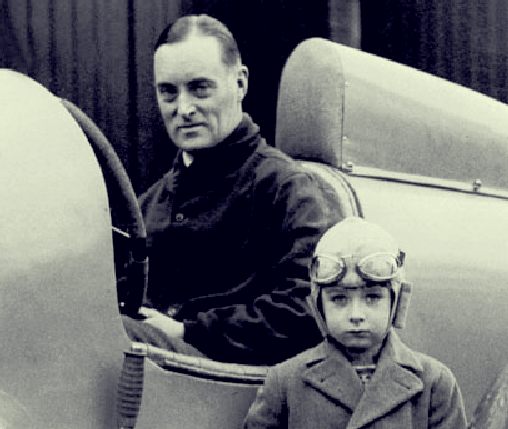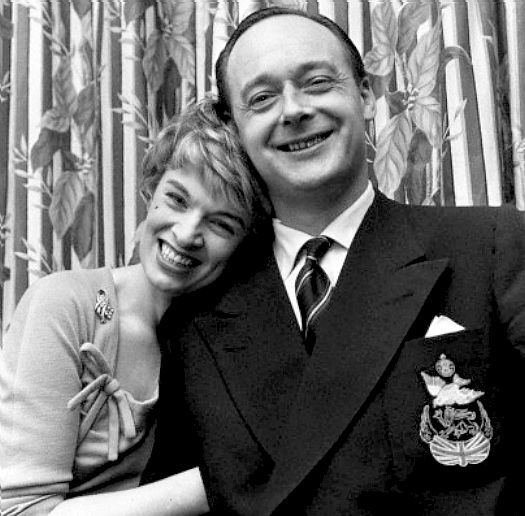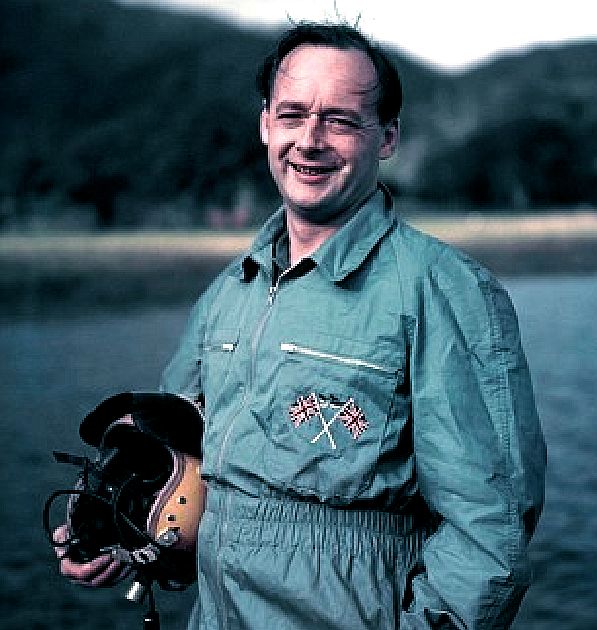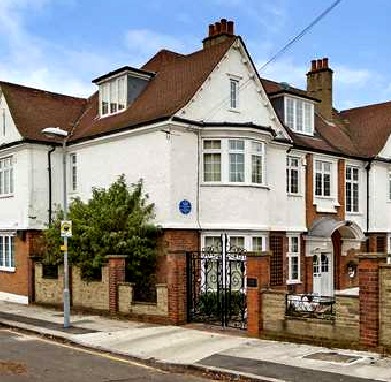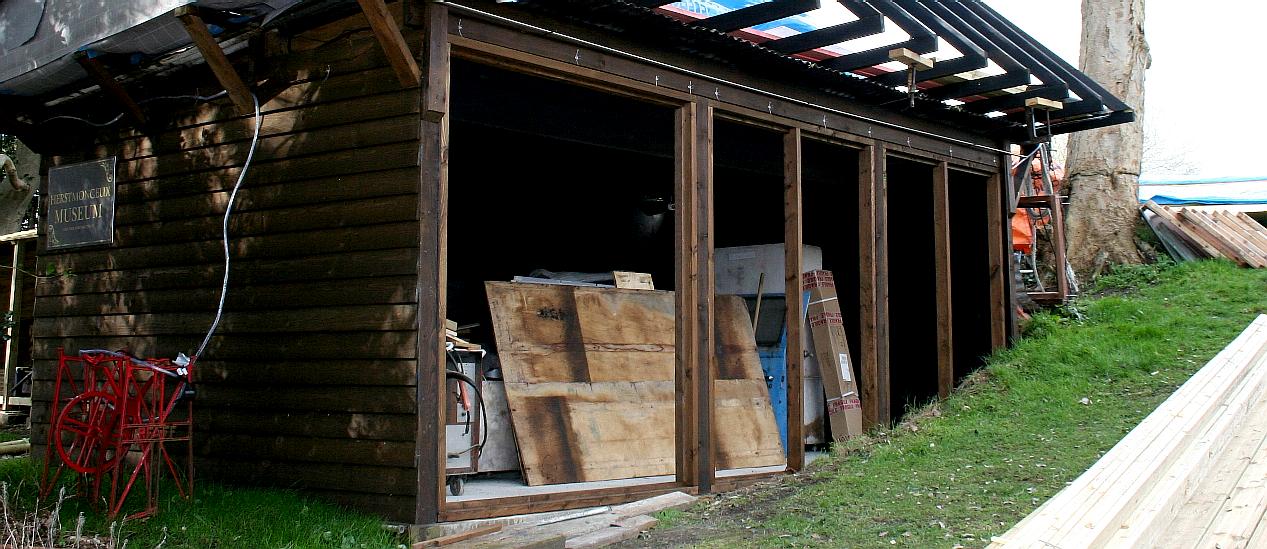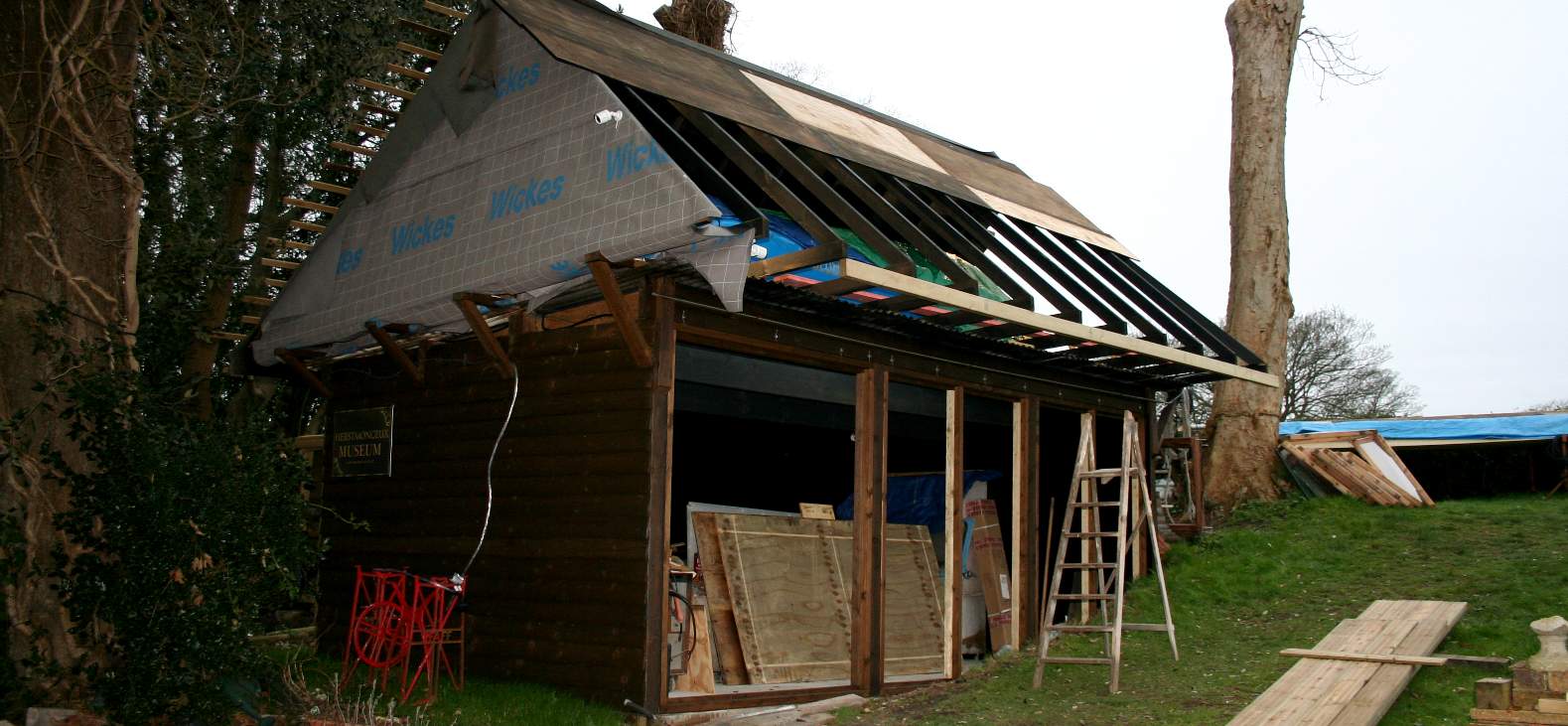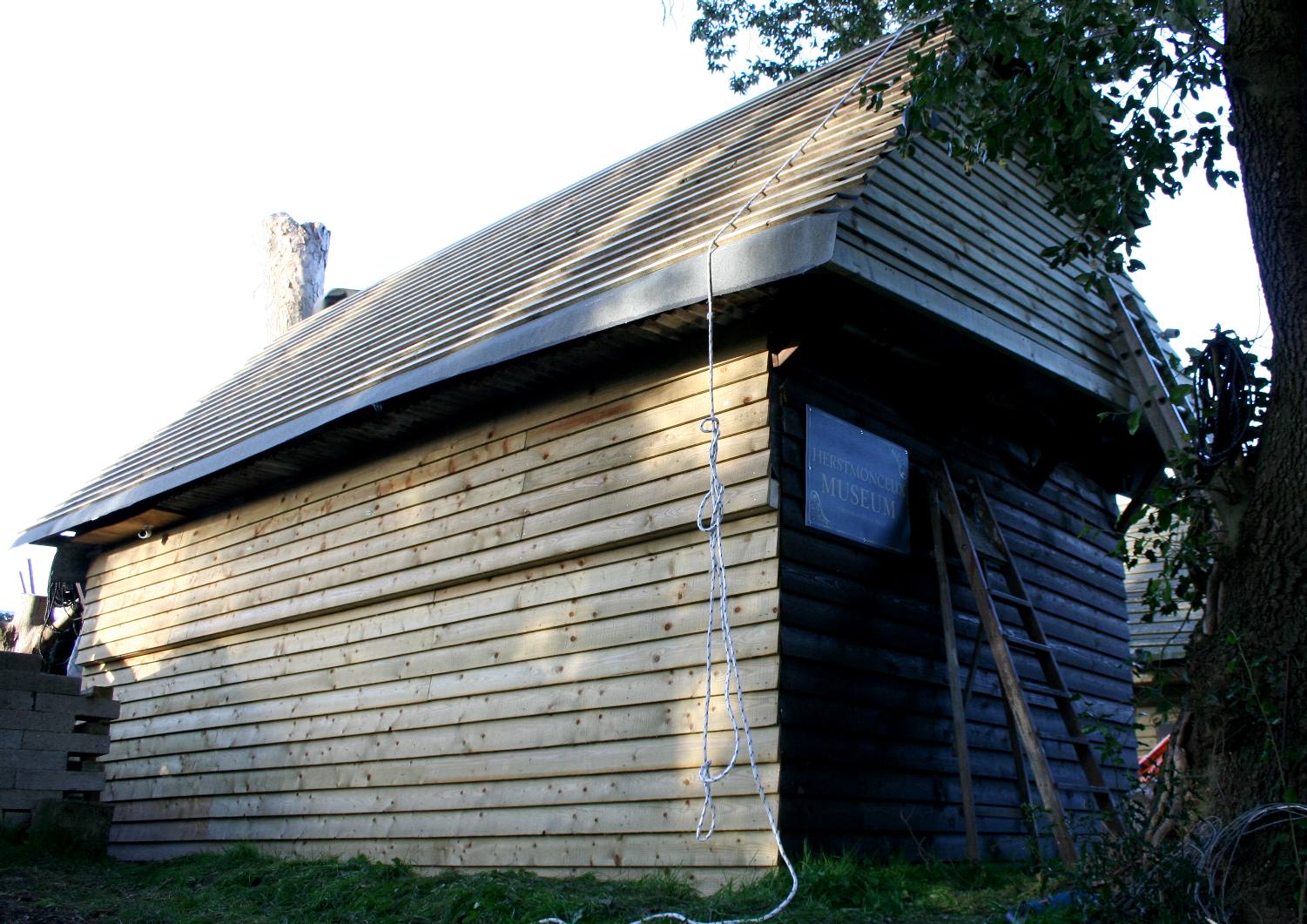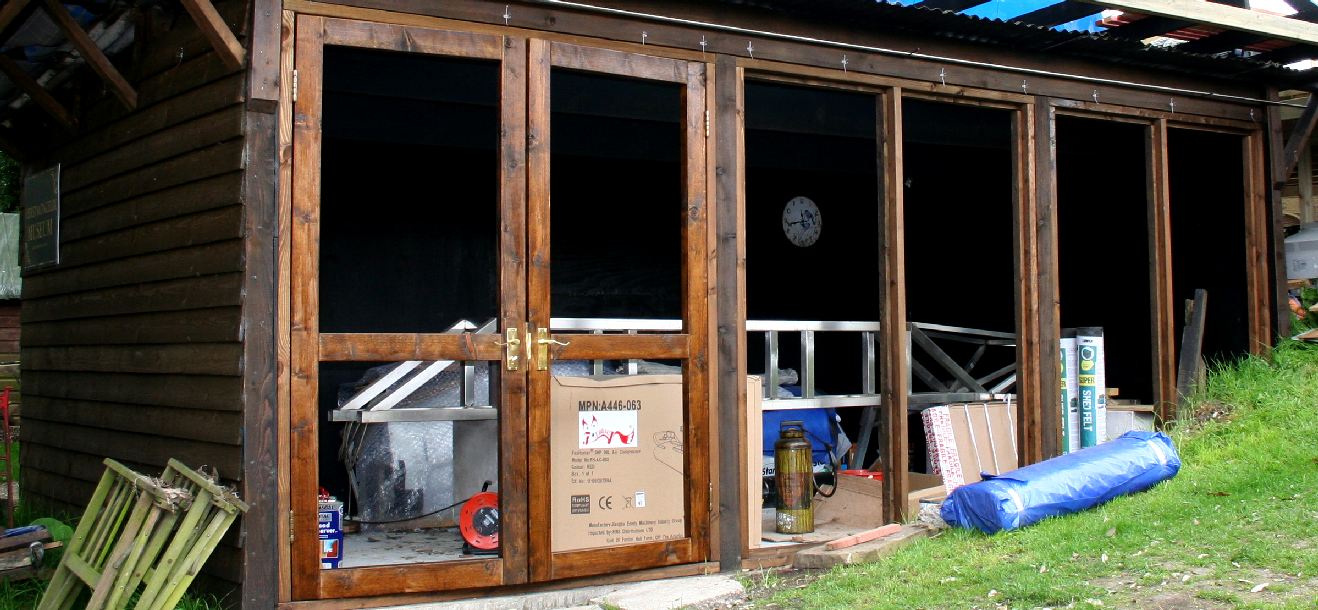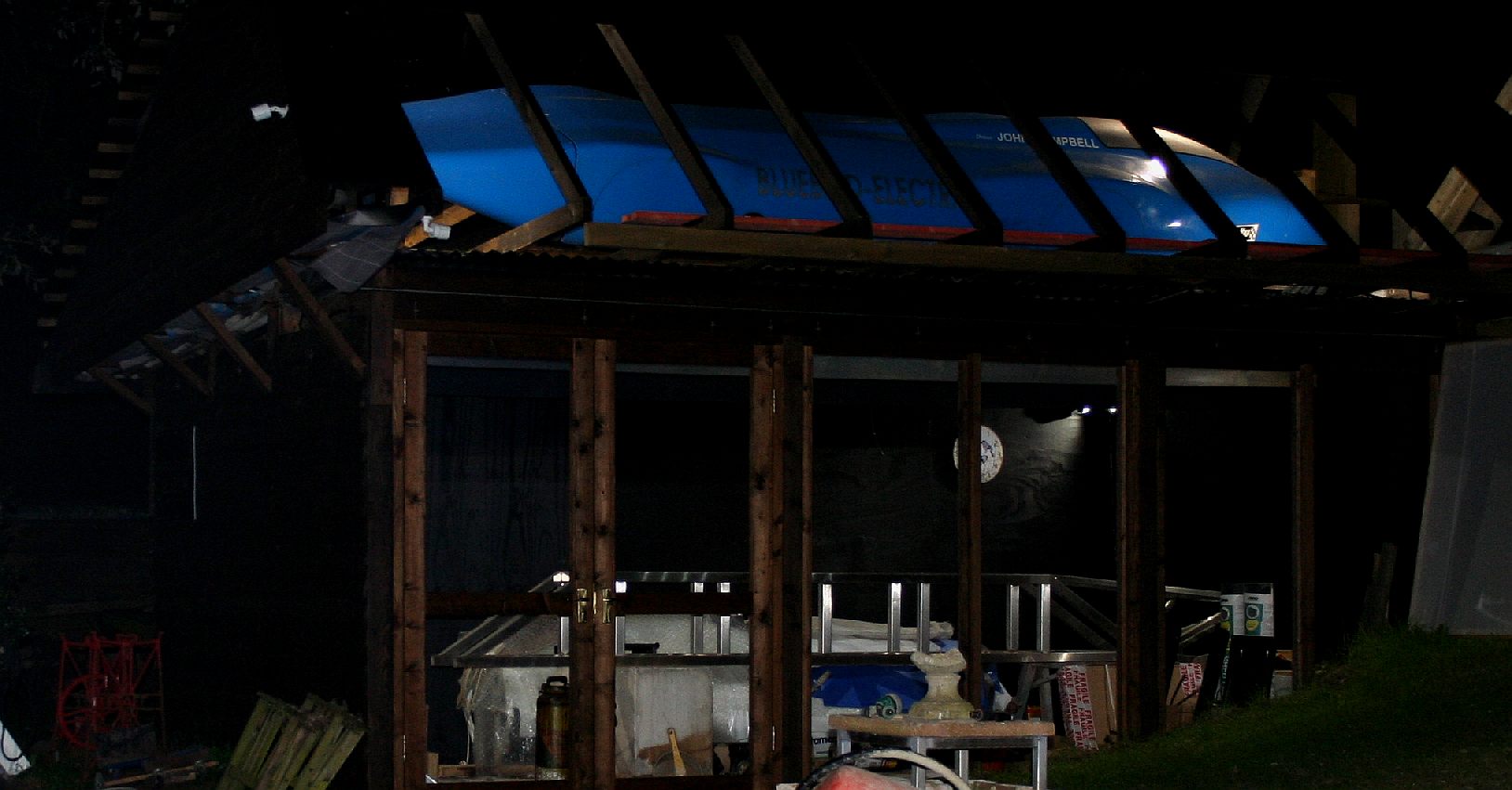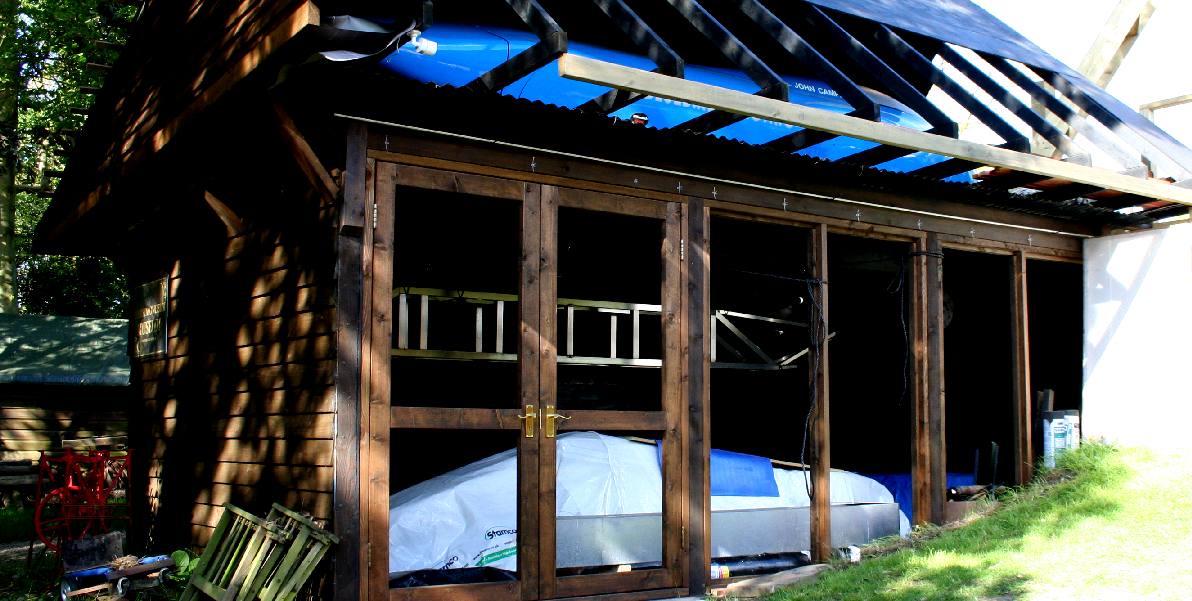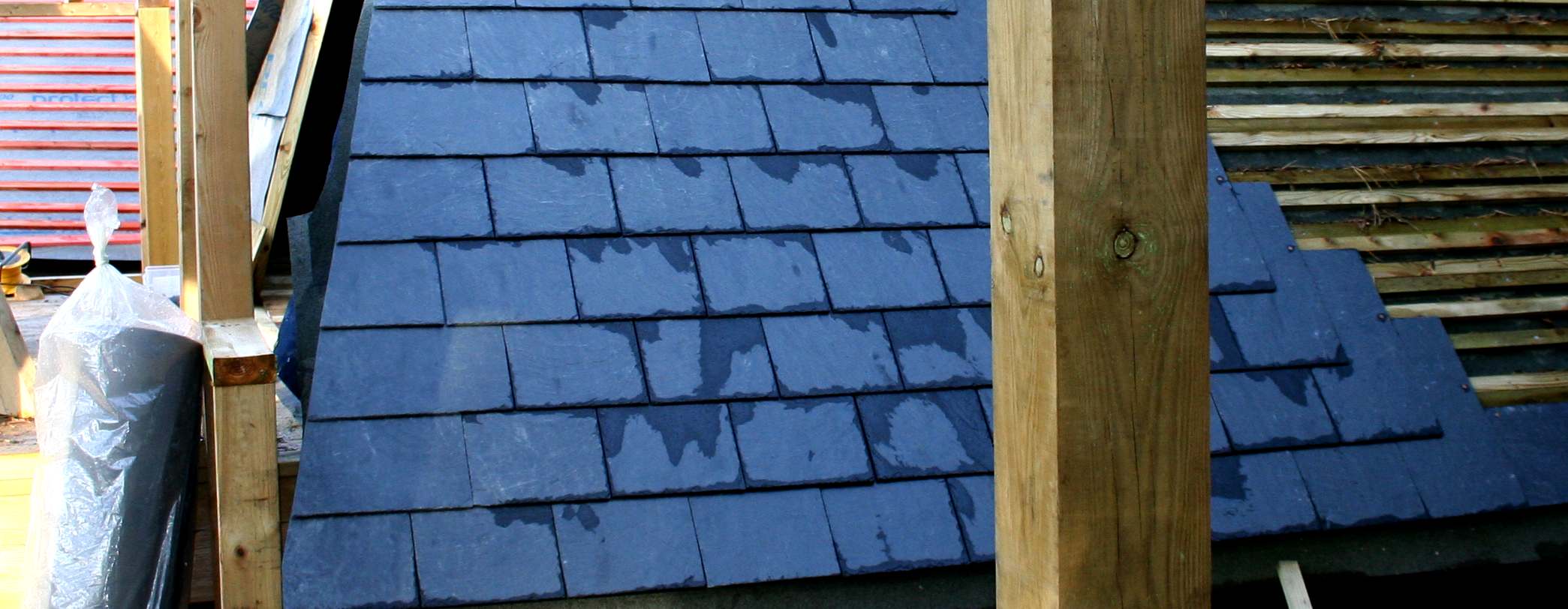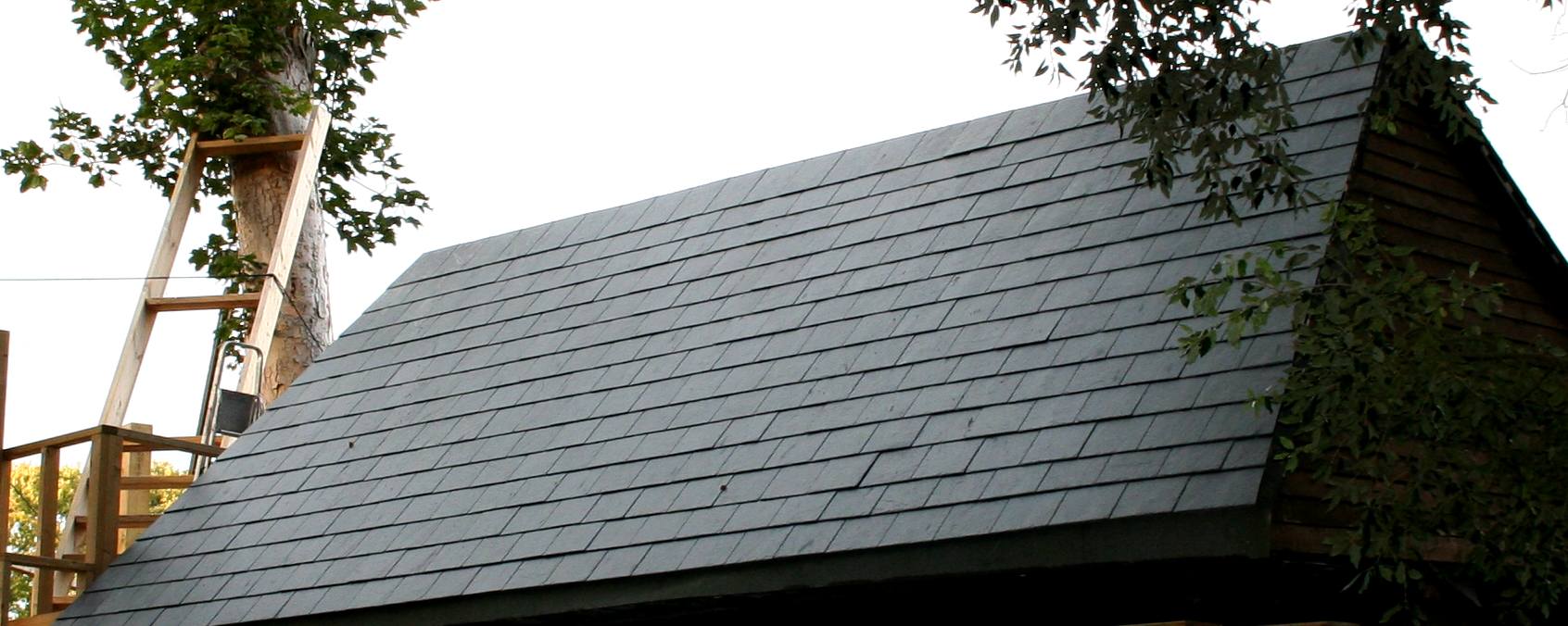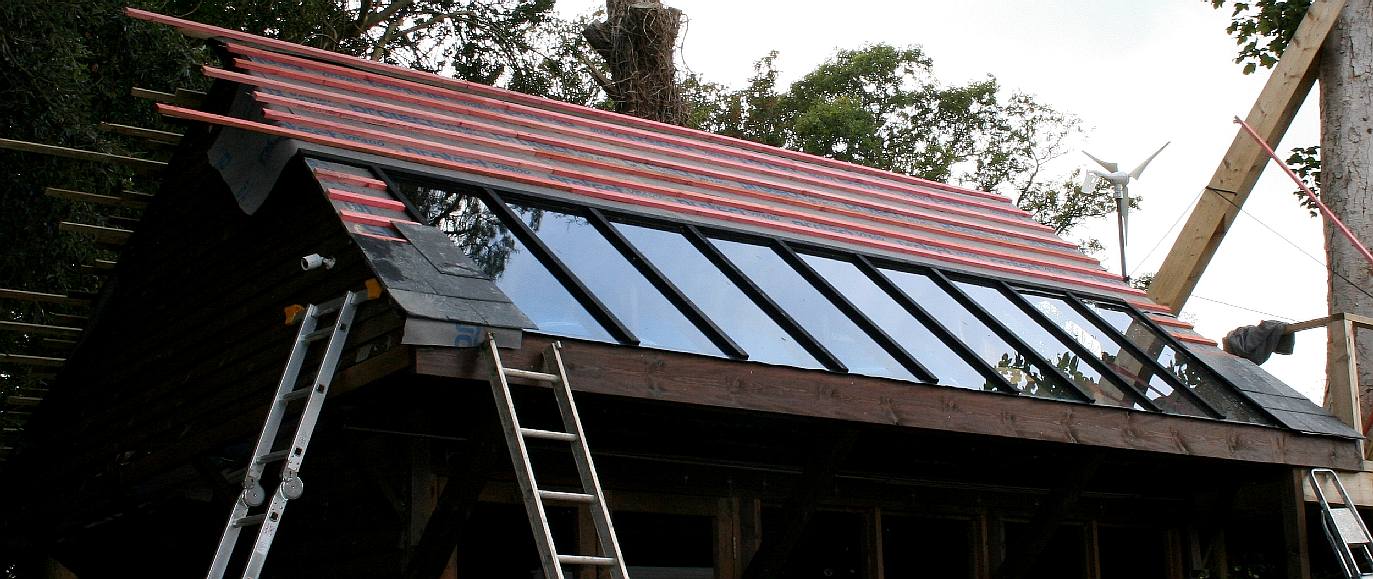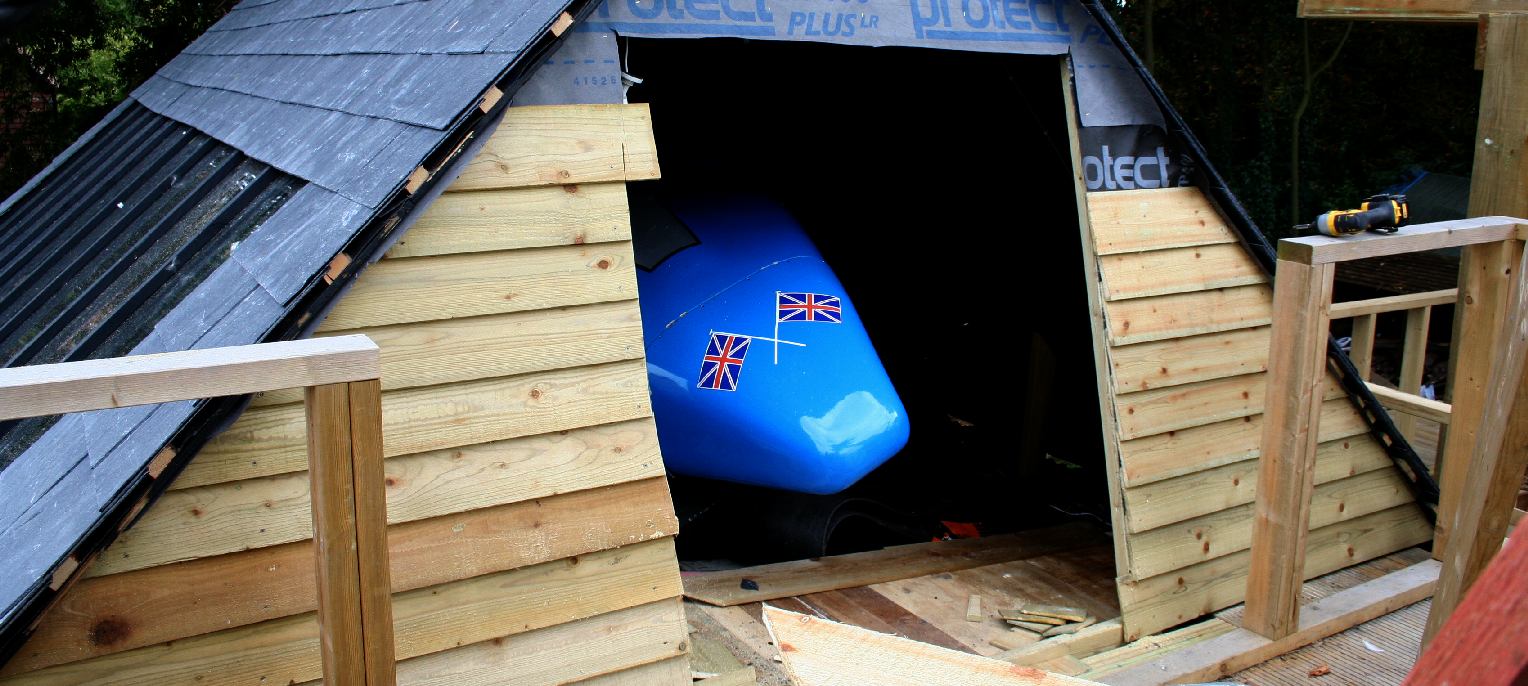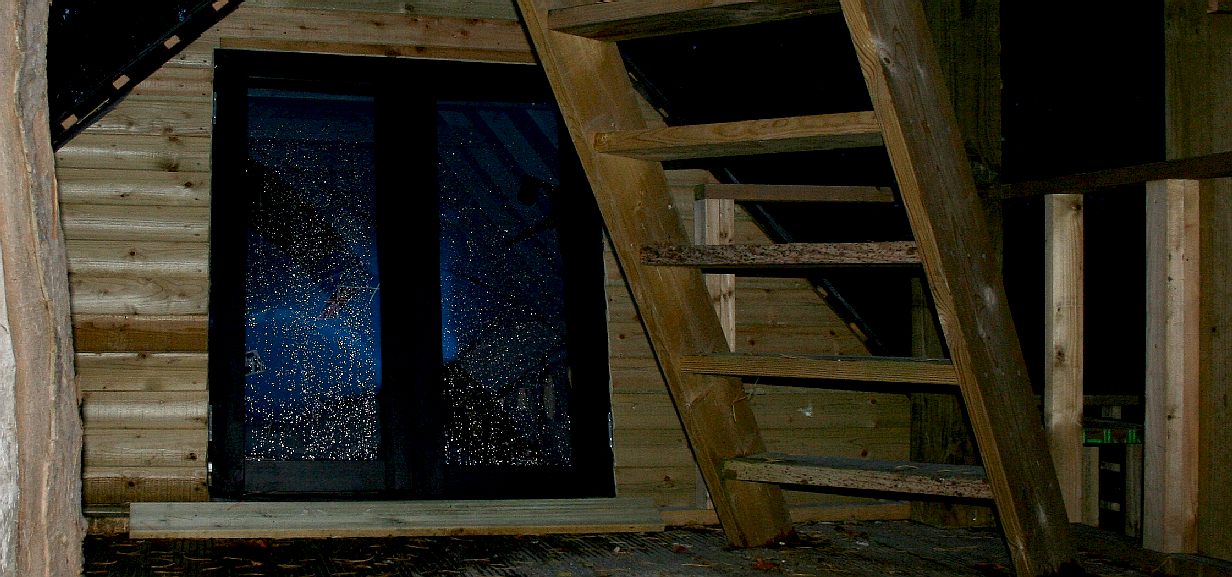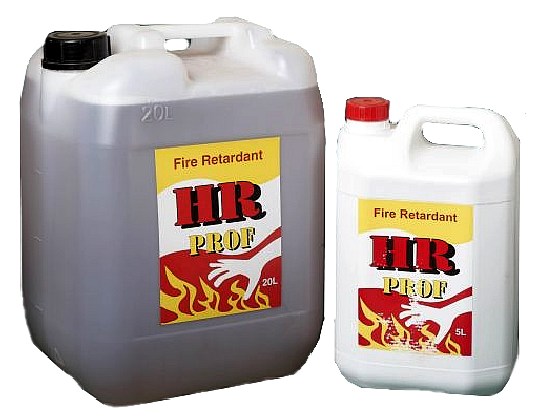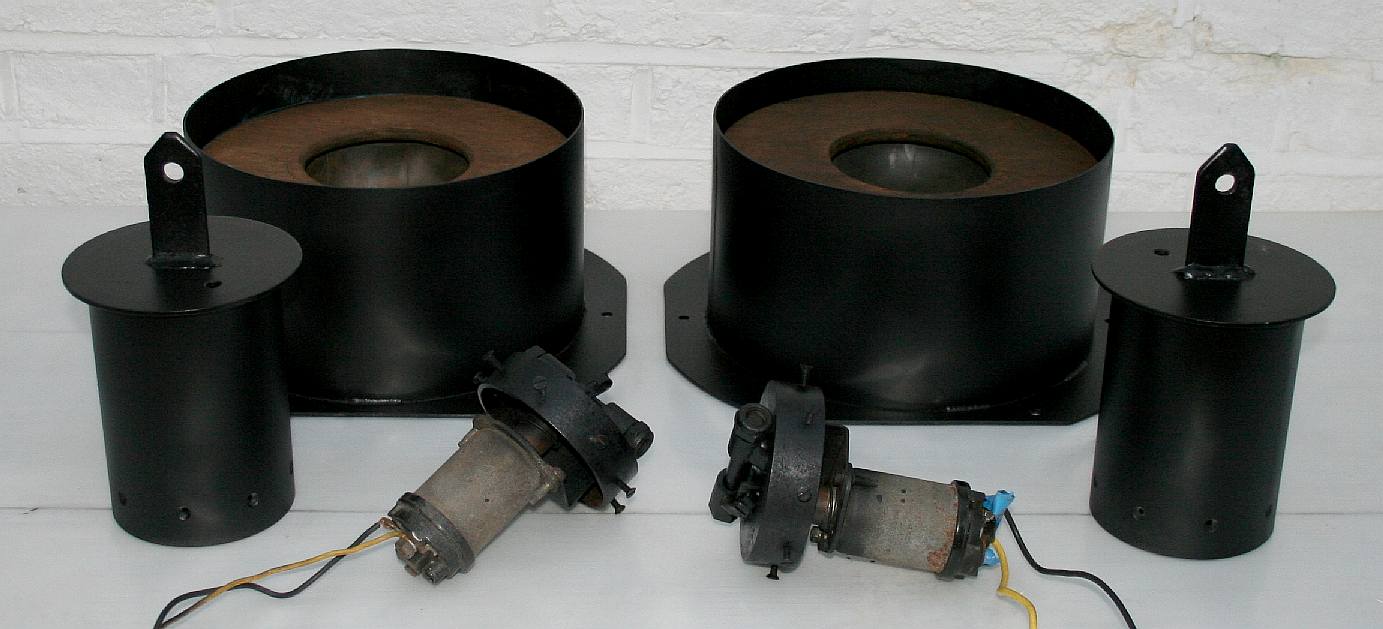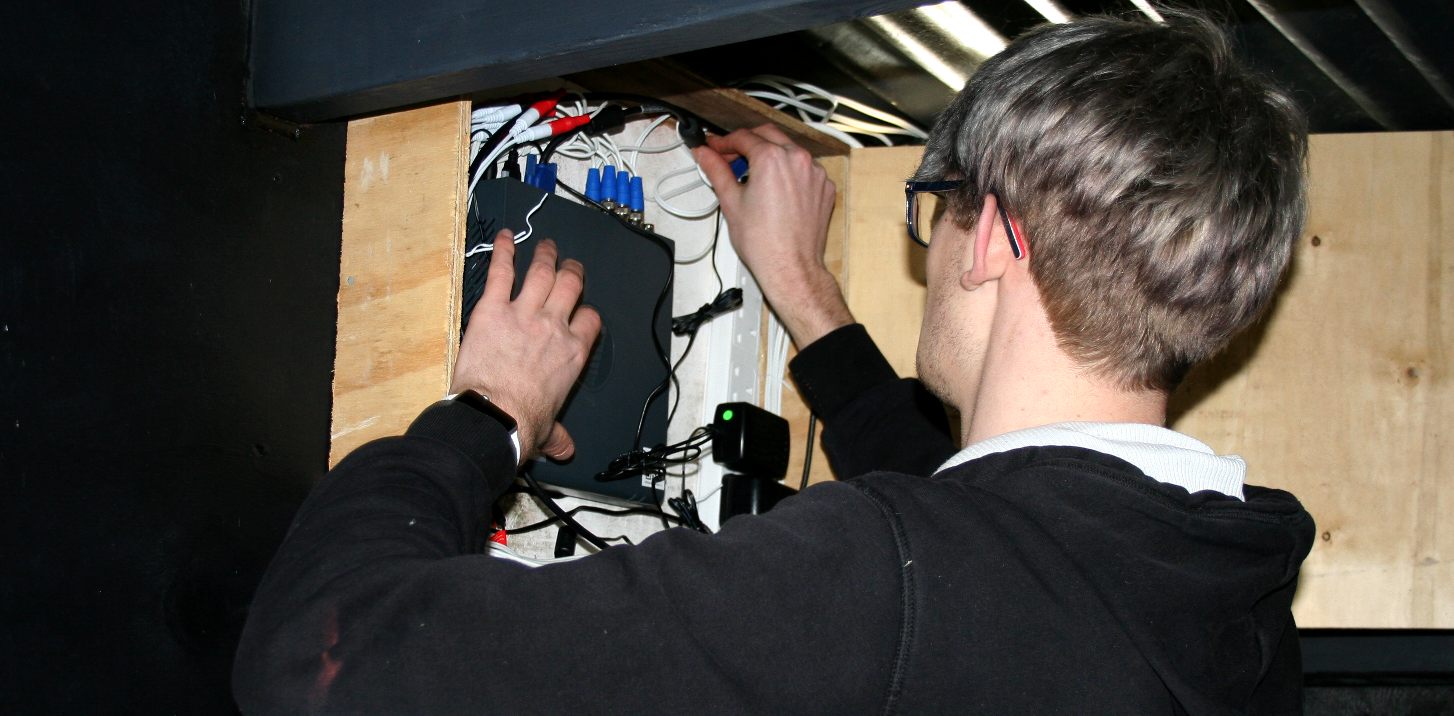|
CAMPBELL HALL
HERSTMONCEUX MUSEUM, E. SUSSEX, UK
|
|||
|
AUTOMOTIVE ART - This was the second car built at Herstmonceux Museum by a local inventor before it became a Museum. The first, a joystick car, we unfortunately cannot track down, but would like to be able to give the "Borzoi" combined-lever (steering, braking and acceleration) prototype a home if that was of interest to the current owner(s). The Bluebird Electric BE1 is/was the first car to be able to exchange batteries itself with built in patented loading equipment, seen here on display at another famous Museum; the National Motor Museum - Beaulieu. This car was driven by the grandson of Sir Malcolm Campbell for media articles, Big Breakfast, and at the LETEC Awards held at the London Arena, but not during any of the high speed runs on the Polegate Bypass where it achieved around 160mph using high speed motorcycle tires and multiple Lynch electric motors. These are not the tires seen in these pictures, about which some people have commented. The tires shown here were ordinary car rubbers on steel rims for delivery purposes only [left] and ordinary motorcycle tyres [right]. Thinner racing motorcycle tires with a circular 'V' casing were fitted on the same (but modified) alloy rims for high speed runs - and it is the faster wheels that the car will be sporting when on virtual display in the Campbell Hall.
AUTOMOTIVE EXHIBITS
While most people will be interested in the archaeology of the building itself as the main exhibit, together with coal bunker, air raid shelter and other underground works, from 1982 onwards a local Sussex engineer produced a remarkable range of machines and other interesting artifacts that demonstrate a wide range of skills and interests to qualify the 'conceptual designer' as a renaissance man, or design genius. The Trust have been fortunate to secure permission to use these items as exhibits for a virtual display, some of which are detailed below, and please note that we will be adding to these pages as more items are unearthed and need a good home.
A joystick controlled car was the first vehicle constructed in the workshops at the Museum, but we cannot locate this car to be able to offer it a home. As a lad the automotive engineer was inspired by Donald Campbell's CN7 bluebird, as seen in the Collins series of books for children. We have that original volume which will be a display item. Later he named his cars Bluebird as a tribute to Ken Norris and Reid Railton, both designers of Bluebird vehicles, with Railton working for Malcolm Campbell and Norris working for Donald Campbell. The grandson of Malcolm Campbell was taken on to drive the electrically powered Bluebirds, as seen in the pictures below, Don Wales was more than pleased to join in with these projects, the aim of the engineer being to promote electric vehicles and his patented cartridge refueling system - as being the ultimate range extender for EVs. Something that Better Place (Shai Agassi) and Tesla (Elon Musk) seem to agree on, but have so far hit a brick wall introducing the benefits in practical terms.
AUTOMOTIVE ART - This was the third car built at Herstmonceux Museum by the same local inventor. Arguably one of the most beautiful land speed record vehicles, the Bluebird Electric BE2 is/was the second car in the series to be able to exchange batteries itself with a built in patented battery recharging system. The car is seen here on display in Chelsea, London at the Bluebird Store, then owned by Sir Terence Conran's group of companies. This car was not driven by the grandson of Sir Malcolm Campbell, Don Wales - seen above - but was used by him under license from the inventor for publicity purposes while a partner with the inventor and while the designer was promoting Mr Wales - the services for which, the inventor alleges, that he was not paid. These vehicles were the means by which Don Wales (previously unknown) entered the land speed record arena. This is the Campbell connection that led the inventor to meet and subsequently consult with Ken Norris, as to the merits of these designs. We are told that Ken liked the steel and stainless steel space frames and all wheel drive concept. Ken Norris and his brother Lewis Norris, were of course, the engineers who designed the famous CN7 jet powered car and K7, jet powered boat for Donald Campbell. Hence, the display that houses these land speed record gems is named: Campbell Hall. Between them, Sir Malcolm Campbell and his son, Donald, set 10 speed records on land and 11 on water. Driving a series of vehicles called Blue Bird, they were the personification of British derring-do and engineering prowess.
ELECTRIC BLUEBIRD DEVELOPMENT HISTORY
The inventor of the cartridge exchange refueling system for electric vehicle lived in Polegate for a time with his wife. While living in this suburb of Eastbourne he met Paul Faulkes-Halbard who at the time was the owner of Filching Manor Motor Museum situated just outside the village of Jevington - famous for Banoffee pie and the Hungry Monk restaurant. Paul was the owner of the K3 blue bird boat of Sir Malcolm Campbell fame, a restoration project now passed to his son Karl Faulkes-Halbard, also a collector of Campbell memorabilia and operator of the Campbell go kart racing circuit.
While a resident in Polegate, the "Bluebird Electric" project was formed by the inventor, when the driving services of Don Wales were secured following a meet up at the Bexhill-On-Sea motoring festival: The Bexhill 100.
The Bluebird-Electric 1 was soon built by hand and on display at Beaulieu and other venues, which succeeded in raising the funds to build the Bluebird-Electric 2 with Sir Terence Conran contributing a significant sum, except that the builder/designer was never paid for his work even though he made the cars and came up with the marketing strategy, applied for and was granted patents, etc., and that is what makes this story so much more intriguing than if there were no rankles in the telling.
PAUL FAULKES-HALBARD - Was an avid collector and restorer of motor vehicles. Paul saved many a vehicle from the scrap heap, lavishing time and money on bringing back into use umpteen vintage and veteran cars and the K3 Blue Bird boat of Sir Malcolm Campbell. The K3 had been left to rot at a fun park when Paul found it and brought it back to his Sussex workshops where it received many hundreds of man hours to put in a new alloy underside, timber frames and deck. A Rolls Royce Merlin derived V12 engine was installed and mated to the original propeller shaft to once again see this magnificent hydroplane on the water. If not for Paul and his son Karl and the team of engineers and craftsmen they had assembled, this boat would long ago have given way to wet rot from being left outside in the rain. you can see these amazing historic vehicles at Filching Manor Motor Museum near Polegate.
It
all started with Malcolm Campbell racing cars in 1910. In 1912 he suffered the first of many near-fatal accidents at the famous
Brooklands race track. This car was christened Blue Bird, after a stage play by
Maurice Maeterlinck, and the name was used for all his subsequent vehicles and those raced by his son, Donald (though Donald used the single word form).
Malcolm
Campbell’s son, Donald, followed in his father’s footsteps, making his first (unsuccessful) attempt on the water speed record in August 1949. He eventually triumphed six years later, taking a new, jet-powered Bluebird to 202.32mph on Coniston Water. For the rest of the decade Campbell ratcheted up more records on water. Following his sixth – 260.35mph in May 1959 – he made an attempt on the land record that nearly proved fatal. In July 1964 he finally claimed the land speed prize at
Lake Eyre salt flats in Australia, recording a speed of 403.14mph.
It turns out that Sir Malcolm and his son Donald Campbell also had moments when they refused to settle with creditors and former project partners. That is no way for public school boys to carry on if they expect to receive applaud for their conduct or even to be knighted as Sir Malcolm was. It was probably cash-flow problems that led to Donald Campbell spectacularly flipping his K7 on Lake Coniston, to the amazement of a shocked world audience. If he'd had more funding, presumably more test tank work would have revealed the instability of the jet boat and the risks Donald was running. Ken Norris was aware of the limitations of the K7 and warned Donald of the dangers, but the rules at the time prohibited air control surfaces and the tailfin on both the CN7 and K7 was pushing the boundaries, where John Cobb's Railton Mobil Special had no fins at all and came close to 400mph.
Ignoring all of that, we have the cars that came out of the business side of the electric land speed record cauldron. A car is a car, it does not try to cheat you. It is an inanimate object until it hits the track or road in the hands of a skilled driver. Cars are part of our culture and necessary for transport in our modern high-octane world. One reason, in fact the main reason for the development of these electric cars, was and is to help stave off global warming in a move to a circular economy. Shame then about the infighting that effectively made the racing aspirations of the driver a no-go for possible sponsors - at least for the foreseeable future. We live in hope.
AUTOMOTIVE TECH - [LEFT] Another of the inventions that were produced at the workshops at Herstmonceux Museum: a desktop sized wind tunnel with electronic strain gauges for measuring aerodynamic lift and down-force, even with a revolving table to examine side winds. This machine was used to develop the BE1 and BE2 cars and still works today, but needs a bit of attention to bring it back to its former glory. [RIGHT] The bare frame of the BE1 land speed record car showing the tunnel that runs through and under the vehicle for battery cartridge exchanges.
Following the LSR fiasco, and with the dust settled, the Ecostar DC50 was born. The little gem of a city sports car is the direct descendant of its electric racing cousins. It is not a paper exercise like other pretenders to the EV throne that abound. It is a real project with something tangible to show for the input of the many contributors and volunteers - and yes it drives when assembled - where at the moment the motors and other parts are kept locked away separately for security purposes and to prevent corrosion while not in use.
So, high hopes for the future of the brand that inspired so many generations of engineers. We must learn from the past to be able to plan for the future - and that is why museums like ours are so important culturally and socially. Herstmonceux Museum is one of the smallest in the UK, potentially qualifying for a Guinness Book World Record one day.
CITY SPORTS CAR - Land speed record breaking is not always totally removed from road cars. This fast little two-seater also has the cartridge recharging system built in so that it can travel long distances and not cause the owner range anxiety, as with so many other production electric vehicles. It is designed for those who want to travel in cities and not have to pay carbon, or congestion charges, such as in London, England.
SHOWCASE - The BE2 is installed in the roof space. It took four strong men to shoehorn the car into the rooftop showcase that will be beefed up structurally as the display is developed. At each stage of construction, fire retardant chemicals were applied to the timbers. The steel ceiling and a slate roof will also adds to the longevity of the structure. A laminated glass roof will be fitted so that visitors to the Museum can observe the vehicle. This may be covered or replaced by corrugated iron or another non-combustible material for long term storage. Before this, this car and the BE1 below were on display in the open air and exposed to the elements, ultra violet light, rain and snow. Fortunately the two-pack paint is really tough. This beautifully streamlined electric car will be spot lit. We call this roof display our observatory, not to be confused with the Observatory a mile or two down the road that houses several very interesting telescopes and domes - and is well worth a 'virtual' visit.
CONTACTS
Herstmonceux East Sussex BN27 1RF, UK
Telephone: 0044 1323 831727 Email: energy@solarnavigator.net
Herstmonceux Museum, including Campbell Hall, is run by the Lime Park Heritage Trust and other not for profit concerns. The plans to admit the public to the site have been abandoned because of the additional administrative burdens and cost where Wealden District Council are not cooperating to help us allow access, but are rather hindering progress, not unusual, as many local businesses and farmers will agree. We recall the case of the soldier helped by crusaders Noel Edmonds and Keith Chegwin, with backing from Gordon Brown and David Cameron - and the 8,000 strong petition that was generated where public feeling was so strong.
The good news is that in the digital age we are planning a virtual tour - hoping that no onerous regulations might crop up for us to allow that to go ahead.
SCENERY - The display case for the Ecostar DC50 tribute car is made from recycled timber. The stack of wooden frames in the foreground were used by the Smooth Faced Gentlemen for umpteen performances of Shakespeare's Titus Andronicus in and around London, including the Pleasance and Greenwich Theatres, between 2012 and 2015. This stagecraft needed to be resistant to water based special effects to simulate the extraordinary bloodletting in this gruesome play. You can see some of the red dye that stained the wood, despite a hectic clean-up schedule after each performance. We are grateful to the Smooth Faced ladies for this contribution to our recycling programme.
FRAMED - It is nearly time to fit the security glass, with the treated timber frames almost completed. At the moment Campbell Hall is filled with overspill from the working element of the Museum. We also need to make two French style doors so that maintenance staff can get in to clean the virtual exhibits from time to time.
FIFTY
YEAR ANNIVERSARY DAILY
MAIL 4 JAN 2017 - According to an article in the Daily
Mail online, the daughter of hero Donald Campbell who died as he attempted a new water speed record has laid flowers on
Coniston Water to mark the 50th anniversary of the
tragedy.
'It was beyond these days of risk assessment and health and safety, and he went out and he did what he did. He did it most times with huge success.'
Before the memorial service began as crowds gathered at the village green, Ms Campbell
is quoted as saying that: "The day had been 'bittersweet'. 'My dad did not do things for public display but I think he would be delighted to see the public here today.'
ENGLISH
HERITAGE - In 1919 Malcolm Campbell moved to Canbury, Kingston Hill, in Kingston-upon-Thames – a substantial two-storey detached house dating from the late 19th
century. The house is now known as Canbury School, Kingston Hill, Kingston KT2 7LN, Royal Borough of Kingston upon Thames.
Malcolm married Dorothy Whittall a year later and it was in this house that their son, Donald, was born in March 1921. On the evening of the birth Malcolm was notoriously absent, helping a neighbour to build a dog kennel, and leaving his father-in-law to call for a midwife.
STAINED - Closer still. Reminiscent of one of Sir Malcolm's and Donald's boat sheds, the frames of Campbell Hall are liberally soaked in wood treatment and coloured to closely match (and complement) the upright posts and feather edge boarding. Copyright photograph © 23 February 2017 all rights reserved. You will need the permission of Lime Park Heritage Trust to reproduce this picture except for education private study or review.
ROOFING - The roof has to be brought down, better to frame the BE2 with a series of laminated glass windows. In this picture you see a pink batten that is used as a guide. The timber at an angle near the eves is to be fixed in place to form a frame for the facias. These basic "A" frames were reinforced at a later date with uprights and cross members. Copyright photograph © 24 February 2017 all rights reserved. You will need the permission of Lime Park Heritage Trust to reproduce this picture except for education private study or review.
TREATMENT - Sheets of plywood have first been treated with wood preserver and then painted black on the underside - where it would be very difficult to paint in-situ with the land speed record car taking up all the space. Tarpaulins protect the electric Bluebird from the building protections. The plywood sheeting adds strength to the structure by diagonally triangulating the unit to prevent lean, but was not necessary where the structure had already stood the test of time. Another way of doing this is with cross-bracing timbers - or both. Building regulations for domestic units like this are not applicable according to government and other planning portals. Copyright photograph © 25 February 2017 all rights reserved. You will need the permission of Lime Park Heritage Trust to reproduce this picture except for educational use, private study or review.
BOARDED - Another row of pre-treated plywood is added to achieve the correct height for the display. The ends need to be trimmed back and the feather-edge boarding completed on the gable end. Copyright photograph © 25 February 2017 all rights reserved. You will need the permission of Lime Park Heritage Trust to reproduce this picture except for education private study or review.
NIGHT - We had run out of timber, so gave the plywood a protective coat of exterior paint, while we wait for another delivery from Stamco in Eastbourne and Hastings. Over the years this company have provided most of the timber for the restoration of the Museum and other improvements. Copyright photograph © 26 February 2017 all rights reserved. You will need the permission of Lime Park Heritage Trust to reproduce this picture except for educational use, private study or review.
RUSTIC - Feather edged boarding is applied to the frames. These tapered timbers are pressure treated to help preserve the wood from the elements, insect attack, dry and wet rot. We will apply another coat of treatment that also colours the wood. We do not use creosote, that only lasts a couple of seasons at best. We use Ronseal wood protection products. Watch the sell by label. Even with this quality brand we have come across mixes that are old, when the waxes used in the formula tend to solidify. Otherwise, this is a great product. Copyright photograph © 9 March 2017 all rights reserved. You will need the permission of Lime Park Heritage Trust to reproduce this picture except for education private study or review.
STABLE MATES REUNITED - The stainless steel frame of the BE3 joins the BE1 and BE2 to combine for a unique Bluebird triple - all electric - LSR display. The BE3s stainless frame is so light it can be supported on one hand above your head, yet still handle 300kW or 400 horsepower - and it can be pimped for more power if the record ever rises above 400mph. At the present rate of motor and battery development that is probably not that far off. It will soon be time to glaze the garage unit with laminated safety/security glass. An alternative would be to board the sides and doors. Copyright photograph © 15 April 2017 all rights reserved. You will need the permission of Lime Park Heritage Trust to reproduce this picture except for education private study or review.
MORE LIGHTS - Not a brilliant picture, but you can get an idea of how the display might work at night. A few more LED spotlights will set the cars off nicely. It looks a mess here with all the building tools cluttering up the cabinets. Copyright photograph © 16 April 2017 all rights reserved. You will need the permission of Lime Park Heritage Trust to reproduce this picture except for education private study or review.
BE1, 2 & 3 - The BE1 is under cover waiting for re-painting in the famous blue that made the Campbell cars stand out. The BE2 is in the roof case and the chassis of the BE3 that is built from stainless steel from Aalco (when they were suppliers to the project and based in Crawley) is suspended in the rafters above other virtual exhibits. Copyright photograph © 18 April 2017 all rights reserved. You will need the permission of Lime Park Heritage Trust to reproduce this picture except for education private study or review.
SERVICE HATCH - At least once a year the cars will need a wash and wax. This is the service entrance for volunteer staff only to be able to keep these stunning electric cars clean. The public would not have been admitted to this building even if the planned opening had gone ahead. Copyright photographs © all rights reserved. You will need the permission of Herstmonceux Museum Ltd to reproduce this picture except for education private study or review.
FEATHER EDGE - Breather membrane is used to allow moisture to escape and prevent water getting in. The roof end is then boarded with treated timbers. Copyright photographs © all rights reserved. You will need the permission of Herstmonceux Museum Ltd to reproduce this picture except for educational use, private study or review.
SLATES - Nothing but the best for these unique historic vehicles. Campbell Hall is not a habitable building nor was it designed to be, but the extra expense of a quality roof means that the whole area is in keeping with the country setting as an asset to the village in terms of local interest. The wooden structure has been reinforced to stand up to hurricanes, where during the storm in 1987 several trees in this location were blown over. Copyright photographs © all rights reserved. You will need the permission of Herstmonceux Museum Ltd to reproduce this picture except for educational use, private study or review.
SLATED REAR - To complete this picture we need the ridge tiles, and the facias & soffits need to be fitted with guttering and down pipes that will feed into the original underground drains from 1900. Copyright photographs © all rights reserved. You will need the permission of Herstmonceux Museum Ltd to reproduce this picture except for educational use, private study or review.
GLAZING - As with the roof, no expense was spared when it came to security, hence, laminated glass was used to blend in with the slate surround, to keep this valuable exhibit protected. Archaeological students and any visiting public are not allowed inside this building which remains locked. This building also features HD cameras that feed data to anywhere in the world. Copyright photographs © all rights reserved. You will need the permission of Herstmonceux Museum Ltd to reproduce this picture except for educational use, private study or review.
DOORWAY - The feather-edge boarding is trimmed to make a neat doorway. Two doors will be custom made for this entrance. Copyright photographs © all rights reserved. You will need the permission of Herstmonceux Museum Ltd to reproduce this picture except for educational use, private study or review.
DOORS - The doors are fitted and glazed with a near unbreakable architectural grade polycarbonate. A very strong security lock is to be fitted once Screwfix deliver an item that they do not keep in store. The feather edge will be treated again with Ronseal all-in-one wood protection to match the other sides of the building. Copyright photographs © October 2017 all rights reserved. You will need the permission of Herstmonceux Museum Ltd to reproduce this picture except for educational use, private study or review.
FIRE
RETARDANT
- HR-Prof has non-flammable properties, which become part of the substrate, restricting ignition and the spread of flame. It will not wash out from the surface of the substrate after drying, it is not converted into smoke when exposed to high temperatures, and carbon char is restricted to the immediate area. Materials treated with HR-Prof when exposed to temperatures of up to 1700 C are subject to charcoal forming, severely restricting the spread of flame.
Apply three coats at one hour intervals. HR-pro can be overcoated.
BUILDING REGULATIONS - For building control purposes Euroclass Certifications are now formally incorporated into Approved Document B which is readilly available on the government web site, office of the Deputy Prime Minister as a PDF document. To download a copy click on this weblink: http://www.planningportal.gov.uk/uploads/br/BR_PDF_ADB_2000.pdf HR-Prof certification is to BS EN 13823 & BS EN 11925-2 SBI Euro class B-sl-d0 (Equivalent to UK Class O BS476 & BS 476: Part 7) Euro-class C (Equivalent to UK Class 1 & 2) for plywood.
HR PROF TOP COAT FINISHES
- A complete fire protection system “Euroclass B Spread of Flame”, HR PROF (Holz Prof) should be applied to the timber in the correct quantity to achieve the required spread of Flame rating, 270m/l in most cases, if an over coating product is required to protect or decorate, the following products are fully compatible for over coating HR PROF (Holz Prof) treated timber;
Other treatments are also compatible. Contact sales & technical: 0800 7833 228 | 01929 400 881 Email: enquiries@fireretardantuk.com
ROOF COMPLETE - The original Bluebird-Electric 2 (BE2) is seen here finally protected from the elements, for generations to come. This was the second electric land speed record car to feature built in power loaded battery cartridge exchange. This would have allowed the car to swap batteries on Pendine Sands if attempting the British record, or the Bonneville Salt Flats if attempting the world record. The car was designed to take the mile record and would have been capable of 300mph plus. Copyright photographs © all rights reserved. You will need the permission of Herstmonceux Museum Ltd to reproduce this picture except for educational use, private study or review.
AIR LIFT SERVO - Regardless of any residual animosity between the designer and his former driver, the concept of a car that can change its own battery cartridges is ground breaking innovation and a legitimate performance enhancer even today in 2017. The pneumatic lifters seen above will be on display outside and ahead of the BE1 car with the battery cartridge suspended from the lifting hooks (also the contactors). This is so that visitors to the museum can see how beautifully the exchanging mechanism was integrated in the overall design of the BE1.
Cartridge exchanges were extremely quick with this system; almost too quick, taking seconds. But this was not a road car, where the mechanism is electrically powered and can be timed for between 15 to 30 seconds or more for the sake of a smooth transfer if necessary. The onboard weight of the concept servos was more than offset by the ability to exchange cartridges twice during a record attempt, significantly increasing the performance of the official "BE" series of land speed record cars. Some pretenders were not equipped with cartridge exchange - and those cars performed badly as a result.
Production servos would be less than half the weight of this robust steel prototype - which was nevertheless a clever design in 1991 when conceived and patented. Copyright photographs © BMS Ltd all rights reserved. You will need the permission of Bluebird Marine Systems to reproduce any of these pictures except for educational use, private study or review.
SURVEILLANCE - Sometimes it is necessary to record who is coming and going, just in case of accidents, insurance claims or other problems. CCTV systems are now widely available at reasonable cost and the quality is stunning with the latest 1080p high definition colour cameras. Here a volunteer tests the installation before it is steel armour encapsulated to prevent vandalism and to preserve evidence of any such incidents. Copyright photographs © 16 February 2017. You will need the permission of the Lime Park Heritage Trust to be able to use these pictures, except for educational and use and private study.
CCTV (closed-circuit
television) is a TV system in which signals are not publicly distributed but are monitored, primarily for surveillance and security purposes.
CCTV relies on strategic placement of cameras and private observation of the camera's input on monitors. The system is called "closed-circuit" because the cameras, monitors and/or video
(hard drive) recorders communicate across a proprietary coaxial cable run or wireless communication link. Access to data transmissions is limited by design.
RIDGE BREATHER - The dry ridge tile system allows this building to breathe to expel moisture and is still pleasing to the eye. The dry system also makes it easier to effect repairs. Where the UK was in the doldrums building wise, General Permitted Development rights have been increased to encourage property owners to expand existing property. So long as the eave and ridge height of the original building is not exceeded you can expand by up to 50% without needing to apply for planning permission. Typically, outbuildings such as garages do not need building regulation approval if more than two meters from the main house provided that the floor area is less than 30 square meters. Habitable units will be subject to building regulations, save for internal remodeling. A garage attached to an existing house will require building regulation approval where there may be structural considerations. Copyright photographs © all rights reserved. You will need the permission of Herstmonceux Museum Ltd to reproduce this picture except for educational use, private study or review.
TIMBERS - Here you can see how the timber supports not only add to the strength of the building but also give character to an otherwise plain storage unit. Treated timbers were used all round. The sycamore tree behind Campbell Hall was saved by reducing the height and providing substantial bracing - ongoing works - designed to retain as much of the fauna around the building as is possible to preserve the leafy atmosphere of the Park. The sycamore is not a protected tree, the Holm oak in front of the unit is protected by a Tree Preservation Order. Copyright photographs © all rights reserved. You will need the permission of Herstmonceux Museum Ltd to reproduce this picture except for educational use, private study or review.
GLASS - Laminated glass is an expensive way to roof a building, but in this case where a historic vehicle is garaged, the Trust thought that it was worth spending a bit more to protect the asset and make the architecture more interesting, both Sir Malcolm and Donald Campbell CBE would have approved. Oddly enough, though both gents built a number of land speed record vehicles, they never made provision for the long-term garaging of their steeds. Fortunately, vehicle enthusiasts and collectors have done that for them, such as Lord Montague of Beaulieu, the National Motor Museum, home to the CN7 Bluebird. Copyright photographs © all rights reserved. You will need the permission of Herstmonceux Museum Ltd to reproduce this picture except for educational use, private study or review.
LINKS
Day out with the kids Museums-and-Galleries http://www.sussex-southdowns-guide.com/sussex-museums http://www.sussextourism.org.uk/ www.sussexpast.co.uk/properties-to-discover/lewes-castle Brighton Royal Pavilion, Libraries & Museums http://fireretardantuk.com/ http://www.planningportal.gov.uk/uploads/br/BR_PDF_ADB_2000.pdf http://www.nationalmotormuseum.org.uk/ https://www.beaulieu.co.uk/ http://www.english-heritage.org.uk/visit/blue-plaques/campbell-malcolm-donald http://www.dailymail.co.uk/news/article-4087226/Speed-hero-Donald-Campbell-s-daughter-lays-flowers-Coniston-Water-50-years-died-trying-smash-record-jet-boat-Bluebird.html http://www.dailymail.co.uk/home/search.html?s=&authornamef=Steph+Cockroft+for+MailOnline http://campbellcircuit.co.uk/ http://www.english-heritage.org.uk/ http://www.thekeep.info/ http://www.heritagegateway.org.uk/gateway/ https://www.sciencedaily.com/releases/2012/10/121021154455.htm http://www.eastsussex.gov.uk/environment/archaeology/default.htm
HERITAGE INDEX A - Z
BARCLAYS BANKING LET DOWN - MISSING ACCOUNT MONEY BARON CARL VON ROEMER & CHARLES de ROEMER CAMPBELL HALL - BLUEBIRD ELECTRIC CARS - BE1 - BE2 - BE3 - BE4 GAS ENGINES - COAL CONVERSION, INTERNAL COMBUSTION OBSERVATORY - HERSTMONCEUX CASTLE SOLAR LADY - STATUE
|
|||
|
This website is Copyright © 2017. All rights reserved. All other trademarks are hereby acknowledged. Contact Us www.cherrymortgages.com |

